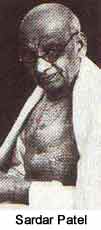

 |  |
 In July, 1927 the Government reduced enhancement to 21.97%. But the concession were too meager and came too late to satisfy anybody.
The peasants began to move towards the 'Ashram' group of Congress leaders. The later, had in the meanwhile contacted Vallabhbhai Patel and were persuading him to take on the leadership of the movement. Patel reached Bardoli on 4th February and immediately had a series of meetings with the representatives of the peasants and the constitutionalist leaders. Patel explained to the peasants the consequences of their proposed plan of action. Following this a meeting of the occupants of Bardoli Taluk passed a resolution advising all occupants of land to refuse payment of the revised assessment until the Government appointed an independent tribunal or accepted the corrected amount as full payment. The Satyagraha had begun. In July, 1927 the Government reduced enhancement to 21.97%. But the concession were too meager and came too late to satisfy anybody.
The peasants began to move towards the 'Ashram' group of Congress leaders. The later, had in the meanwhile contacted Vallabhbhai Patel and were persuading him to take on the leadership of the movement. Patel reached Bardoli on 4th February and immediately had a series of meetings with the representatives of the peasants and the constitutionalist leaders. Patel explained to the peasants the consequences of their proposed plan of action. Following this a meeting of the occupants of Bardoli Taluk passed a resolution advising all occupants of land to refuse payment of the revised assessment until the Government appointed an independent tribunal or accepted the corrected amount as full payment. The Satyagraha had begun.Vallabhbhai Patel was ideally suited for leading the campaign. A veteran of ther Kheda satyagraha, the Nagpur flag satyagrahs, he emerged as the leader of Gujarat who was second only to Gandhiji. His capacities as an organizer, speaker were already known, but it was the women of Bardoli who gave him the title of 'Sardar'. The main mobilization was done through extensive propaganda via meetings, speeches, pamphlets and door to door persuasion. Special emphasis was laid on the mobilization of women and many women activists like Mithubehn Petit, a Parsi lady from Bombay, Bhakti Ba, Shardabehn Shah, Sharda Mehta and Manibehn Patel, the Sardar's daughter were recruited for the purpose. Sardar Patel and his colleagues made constant efforts to see that they carried the constitutionalist and moderate leadership as well as public opinion with them. Public opinion in the country was getting more and more restive and anti-Government. The face saving device was provided by the legislative council members from Surat who wrote letter to the Governor assuring him that his pre condition for an enquiry would be satisfied. The enquiry conducted by a judicial officer, Broomfield, and a revenue officer Maxwell, came to the conclusion that the increase had been unjustified and reduced the enhancement to 6.03%. next page >> |
Copyright ©2000 indiansaga.info. All rights reserved.
By using this service, you accept that you won't copy or use the data given in this website for any commercial purpose.
The material on indiansaga.info is for informational & educational purpose only.
This site is best viewed at 800 X 600 picture resolution.